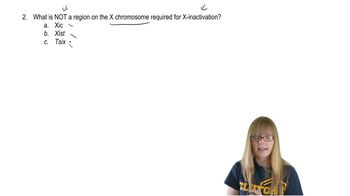Table of contents
- 1. Introduction to Genetics51m
- 2. Mendel's Laws of Inheritance3h 37m
- 3. Extensions to Mendelian Inheritance2h 41m
- 4. Genetic Mapping and Linkage2h 28m
- 5. Genetics of Bacteria and Viruses1h 21m
- 6. Chromosomal Variation1h 48m
- 7. DNA and Chromosome Structure56m
- 8. DNA Replication1h 10m
- 9. Mitosis and Meiosis1h 34m
- 10. Transcription1h 0m
- 11. Translation58m
- 12. Gene Regulation in Prokaryotes1h 19m
- 13. Gene Regulation in Eukaryotes44m
- 14. Genetic Control of Development44m
- 15. Genomes and Genomics1h 50m
- 16. Transposable Elements47m
- 17. Mutation, Repair, and Recombination1h 6m
- 18. Molecular Genetic Tools19m
- 19. Cancer Genetics29m
- 20. Quantitative Genetics1h 26m
- 21. Population Genetics50m
- 22. Evolutionary Genetics29m
13. Gene Regulation in Eukaryotes
Overview of Eukaryotic Gene Regulation
Problem 18a
Textbook Question
The UG4 gene is expressed in stem tissue and leaf tissue of the plant Arabidopsis thaliana. To study mechanisms regulating UG4 expression, six small deletions of DNA sequence upstream of the gene-coding sequence are made. The locations of deletions and their effect on UG4 expression are shown here. Explain the differential effects of deletions B and F on expression in the two tissues.
 Verified step by step guidance
Verified step by step guidance1
<Step 1: Identify the role of upstream sequences in gene expression. These sequences often contain regulatory elements such as promoters, enhancers, or silencers that control when and where a gene is expressed.>
<Step 2: Examine the specific locations of deletions B and F. Determine if these deletions overlap with known regulatory elements that could affect gene expression differently in stem and leaf tissues.>
<Step 3: Consider the possibility that deletion B might remove or alter a regulatory element that is specific to one tissue type, such as an enhancer active in stem tissue but not in leaf tissue.>
<Step 4: Similarly, analyze deletion F to see if it affects a different regulatory element, potentially one that is active in leaf tissue but not in stem tissue.>
<Step 5: Hypothesize how these deletions could lead to differential expression by either disrupting tissue-specific enhancers or silencers, leading to changes in UG4 expression levels in stem versus leaf tissues.>
Recommended similar problem, with video answer:
 Verified Solution
Verified SolutionThis video solution was recommended by our tutors as helpful for the problem above
Video duration:
1mPlay a video:
Was this helpful?
Key Concepts
Here are the essential concepts you must grasp in order to answer the question correctly.
Gene Expression Regulation
Gene expression regulation involves various mechanisms that control the timing and level of gene expression. This can include transcription factors, enhancers, and silencers that interact with DNA sequences to either promote or inhibit the transcription of a gene. Understanding these regulatory elements is crucial for analyzing how specific deletions can affect gene expression in different tissues.
Recommended video:
Guided course

Penetrance and Expressivity
Promoter and Enhancer Regions
Promoter and enhancer regions are specific DNA sequences located upstream of a gene that play a critical role in initiating transcription. Promoters are typically located immediately adjacent to the gene, while enhancers can be located further away. Deletions in these regions can disrupt the binding of transcription factors, leading to differential expression of the gene in various tissues, such as stem and leaf tissue in Arabidopsis thaliana.
Recommended video:
Guided course

Regions of X Chromosomes
Tissue-Specific Expression
Tissue-specific expression refers to the phenomenon where certain genes are expressed in specific tissues or developmental stages. This is often regulated by the presence of unique transcription factors or regulatory elements that are active only in certain tissues. Analyzing how deletions B and F affect UG4 expression in stem versus leaf tissue can reveal insights into the mechanisms that govern tissue-specific gene regulation.
Recommended video:
Guided course

Penetrance and Expressivity

 9:22m
9:22mWatch next
Master Review of Regulation with a bite sized video explanation from Kylia Goodner
Start learningRelated Videos
Related Practice


